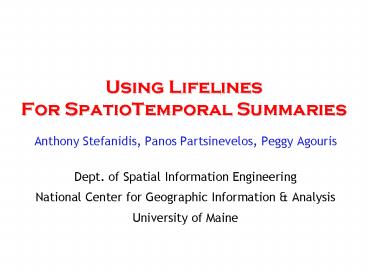Using Lifelines For SpatioTemporal Summaries - PowerPoint PPT Presentation
1 / 32
Title:
Using Lifelines For SpatioTemporal Summaries
Description:
spatiotemporal data reduction through the identification of important instances/frames ... spatiotemporal generalization using variable resolution as dictated ... – PowerPoint PPT presentation
Number of Views:50
Avg rating:3.0/5.0
Title: Using Lifelines For SpatioTemporal Summaries
1
Using Lifelines For SpatioTemporal Summaries
- Anthony Stefanidis, Panos Partsinevelos, Peggy
Agouris - Dept. of Spatial Information Engineering
- National Center for Geographic Information
Analysis - University of Maine
2
Our Digital Government Project
- Title Knowledge Management Over Time Varying
Geospatial Datasets - Academic Partners
- University of Maine (lead)
- Penn State University
- University of California - Riverside
- Duration Aug. 2000 - July 2003
3
Agency/Industry Partners
- Direct
- National Imagery Mapping Agency (NIMA)
- National Agricultural Statistics Service (NASS)
- BAE Systems
- Indirect
- Open GIS Consortium (OGC)
- US Army Topographic Engineering Center (TEC)
- Federal Geographic Data Committee (FGDC)
4
Project Objective
- The development of novel meta-information
structures conveying the content of time varying
geospatial dataset collections, in order to
improve access to and enable the analysis of such
information
5
Paper Objective
- The automatic generation of video summaries.
- Providing support for
- spatiotemporal data reduction through the
identification of important instances/frames - spatiotemporal generalization using variable
resolution as dictated by information content - spatiotemporal behavioral analysis
6
- Lifelines S-T trajectories
- Need Generalization of S-T trajectories through
- selection of representative frames
7
- Object Trajectories
- as Paths in Multidimensional S-T Spaces
8
SOM Extraction of a Curvilinear Medial Axis
9
SOM Extraction (cont.)
Convergence
Ordering achieved
10
Input Imagery
Noisy MLC Results
HYDICE Test Area 1
11
SOM In SpatioTemporal Data
- S-T Nodes
- correspond to video frames (or datasets)
- of nodes generalization degree
- captures spatial and temporal behavior
12
S-T vs. S data
- S-T trajectories differ fundamentally from roads
in that they are not as smooth or regular - We need a better generalization approach to
minimize information loss and redundancy
13
Standard SOM Generalization
- Problems
- Makes use of a preselected of nodes
- Handles poorly geometrically complex areas
14
A New Hybrid SOM
- Analysis of geometric complexity of generalized
trajectory - Introduction of mini-SOM solutions in complex
data pockets - Removal of redundant nodes
- Zooming-in in complex instances and zooming-out
otherwise
15
Single object
Capture spatial and temporal variations turns,
ac/deceleration
16
Outline
t(2) t(1)
tracking
S-T trajectories
Area of interest
Proximity
Topology
Video dataset
SOM
Patches of moving object
Averaging, New Video
Node registration
Rough generalization
t
Thinning
t
x
y
Geometric-SOM generalization
S-T Summary
17
Geometry-SOM Technique
Thinning
Densification
18
Geometry-SOM
19
Generalization Detail
20
Accuracy Measures
- SOM vs. Hybrid
RMS(SOM) 89.3 RMS(Hybrid) 8.9
21
S-T SOM Nodes
- Instances where the object
- Accelerated/decelerated
- Changed orientation
22
Additional S-T Nodes
- Analyzing other spatial properties of
- single objects or relations among
- multiple objects
- Topology
- Proximity
- User-defined
23
Additional Nodes
Proximity
Reasoning
Area of Interest
24
Proximity Experiments
25
Data Handling
s (or t)
O1 O2 O3 O4
26
Lifeline Resolution
Attributes
Scale
Navigate through hierarchical structure in
information content and volume
27
Summary Generation
- Integrating S-T nodes
- SOM
- proximity
- reasoning
- Registration and grouping
- as average (titj)/2
- as video segment from t(I) to t(j)
28
Supported Queries
How similar are the S-T trajectories of two
objects?
Total Attribute Similarity (Partial Attribute
Similarity Indices)
3-D similarity
29
Find all objects for which a specific attribute
varied in a specific way over a certain extent.
Query increment
O1
O2
Object1 53 Object2 75
30
Scale Independent Comparisons
- Differential registration
- Lifeline stretching to reveal hidden relations.
31
Event Similarity Matching
- Crime rate
- Pollution
Urban Growth
Relations
32
To Be Continued
For more information http//www.spatial.maine.
edu/peggy/dgi.html or tony_at_spatial.maine.edu































